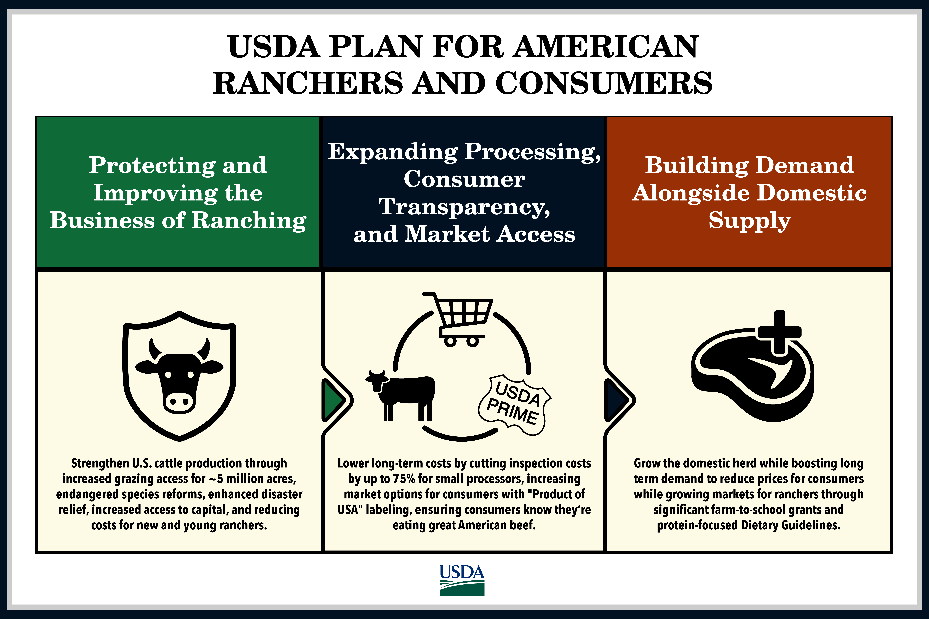October 22, 2025 – Washington, D.C.

After a week of growing anger from ranchers over President Trump’s beef import remarks, the administration rolled out a sweeping recovery package designed to reassure rural America that “America’s ranchers come first.” The new plan, announced jointly by Agriculture Secretary Brooke L. Rollins, Interior Secretary Doug Burgum, Health and Human Services Secretary Robert F. Kennedy Jr., and Small Business Administrator Kelly Loeffler, outlines what officials call “the most comprehensive federal action on beef in a generation.”
According to the USDA Beef Industry Plan White Paper, the U.S. has lost more than 150,000 cattle operations since 2017, a decline of about 17 percent, while the national herd has fallen to a 75-year low. At the same time, consumer demand for beef has climbed roughly 9 percent. The administration argues that the imbalance threatens both rural economies and national security, framing ranching as “an essential pillar of America’s food defense.”
What the Plan Promises

The plan rests on three pillars:
Protect and Improve the Business of Ranching.
A forthcoming USDA–DOI Grazing Action Plan will reopen vacant federal grazing allotments, streamline permitting, and establish a formal inter-agency “one-stop” system for ranchers who work across U.S. Forest Service and Bureau of Land Management boundaries. It also expands predator-loss compensation and boosts disaster programs such as the Livestock Indemnity Program to cover unborn calves. New subsidies will cut insurance costs for beginning ranchers, and the AgVets Program will prioritize veterans entering ranching
Expand Processing, Transparency, and Market Access.
USDA’s Food Safety and Inspection Service will start enforcing a tougher “Product of USA” label on January 1, 2026—limiting the claim to beef born, raised, and slaughtered in the United States. Smaller processors will see inspection-fee cuts of up to 75 percent, and new rounds of Meat and Poultry Processing Expansion Program grants could inject $100 million into local facilities. EPA’s withdrawal of a 2024 wastewater rule and clarification of Clean Water Act jurisdiction are projected to save processors $1.1 to $7.8 billion in compliance costs

Build Demand Alongside Domestic Supply.
The plan directs school lunch programs to buy more locally raised beef, expands Farm-to-School grants up to $500,000 each, and pledges that upcoming Dietary Guidelines for Americans (2025–2030) will highlight beef as a nutrient-dense “whole food.”
Addressing the Backlash
Many producers saw last week’s remarks by President Trump—suggesting short-term imports to offset tight supplies—as a betrayal. Critics argued the administration was “selling out” U.S. ranchers just as they faced record feed and fuel costs. Today’s rollout appears intended to blunt that anger.

“This is a bid to regain trust,” said one Colorado cattleman reached after the press event. “If these reforms really reopen grazing allotments and fix the labeling loopholes, it could make a difference—but folks are watching closely.”
Secretary Rollins framed the effort in national-security terms: “America’s food supply chain is a national security priority for the Trump Administration. We are protecting our beef industry and incentivizing new ranchers to take up the noble vocation of ranching.”
Interior Secretary Burgum promised to “restore grazing access on public lands,” while Secretary Kennedy tied the initiative to health policy—“We cannot Make America Healthy Again without America’s farmers and ranchers.”
To view the plan, please click here.
Help support our work by buying our books:

Check out our latest on Amazon.com

Check out our latest on Amazon.com

Check out our latest on Amazon.com


Leave a Reply
You must be logged in to post a comment.